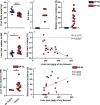Seasonal and fasting induced changes in iron metabolism in Djungarian hamsters
- PMID: 37930992
- PMCID: PMC10627461
- DOI: 10.1371/journal.pone.0293971
Seasonal and fasting induced changes in iron metabolism in Djungarian hamsters
Abstract
Djungarian hamsters are small rodents that show pronounced physiological acclimations in response to changes in photoperiod, and unfavorable environmental conditions such as reduced food availability and low external temperature. These include substantial adjustments, such as severe body weight loss and the use of daily torpor. Torpor is a state of decreased physiological activity in eutherms, usually marked by low metabolic rate and a reduced body temperature. In this study, we investigated the effects of photoperiodic acclimation and food deprivation on systemic iron metabolism in Djungarian hamsters. Our study illustrates the association between liver iron levels and the incidence of torpor expression during the course of the experiment. Moreover, we show that both, acclimation to short photoperiods and long-term food restriction, associated with iron sequestration in the liver. This effect was accompanied with hypoferremia and mild reduction in the expression of principal iron-hormone, hepcidin. In addition to iron, the levels of manganese, selenium, and zinc were increased in the liver of hamsters under food restriction. These findings may be important factors for regulating physiological processes in hamsters, since iron and other trace elements are essential for many metabolic and physiological processes.
Copyright: © 2023 Kawach et al. This is an open access article distributed under the terms of the Creative Commons Attribution License, which permits unrestricted use, distribution, and reproduction in any medium, provided the original author and source are credited.
Conflict of interest statement
The authors have declared that no competing interests exist.
Figures





References
Publication types
MeSH terms
LinkOut - more resources
Full Text Sources
Medical

